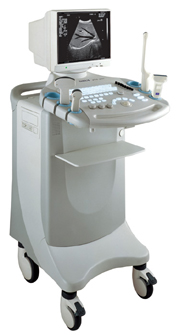Medical Ultrasound Imaging
Tuesday, 21 May 2024
'Real Time' p3 Searchterm 'Real Time' found in 22 articles 5 definitions [ • ] - 17 booleans [• ]Result Pages : •  From SIUI Inc.;
From SIUI Inc.;'Dedicated to ultrasound industry, Shantou Institute of Ultrasonic Instruments, Inc. (SIUI) has launched Apogee 3500, the Digital Color Doppler Ultrasound Imaging System. With latest imaging technologies, high-definition image quality and excellent practical functions, the Apogee 3500 offers optimal solutions for clinical ultrasonic examination.' 'The Apogee 3500 is available with many high-density, super broadband and multi-frequency probes, such as convex, micro-convex, linear, vaginal, rectal and phased array probes, which are widely applied for different clinical diagnoses, including abdomen (liver, kidney, gall-bladder, pancreas), gynecology (uterus, ovary), obstetrics (early pregnancy, basic OB, complete OB, multi gestation, fetal echo), cardiology (adult and pediatric cardiology), small parts (thyroid, galactophore, testicles, neonate), peripheral vascular and prostate.'
Device Information and Specification
CONFIGURATION
Normal system, color - gray scale(256)
Linear, convex and phased array
PROBES STANDARD
2.0 MHz ~ 12.0 MHz, broad band, tri-frequency
B-mode (B, 2B, 4B), M-mode, B/M-mode, real-time compound imaging, panoramic imaging, trapezoidal imaging (linear probes), spectrum Doppler (PWD and CWD), color Doppler flow imaging (CDFI), color power angio (CPA), tissue harmonic imaging (THI)
IMAGING OPTIONS
Real-time ZOOM, zoom rate and position selectable
OPTIONAL PACKAGE
H*W*D m
1.29 * 0.52 * 0.75
WEIGHT
110 kg
POWER REQUIREMENT
AC 220V/110V, 50Hz/60Hz
POWER CONSUMPTION
0.6 KVA
•
A piezoelectric crystal changes the physical dimensions when subjected to an electric field. When deformed by external pressure, an electric field is created across the crystal. Piezoelectric ceramic and crystals are used in ultrasound transducers to transmit and receive ultrasound waves. The piezoelectric crystal in ultrasound transducers has electrodes attached to its front and back for the application and detection of electrical charges. The crystal consists of numerous dipoles, and in the normal state, the individual dipoles have an oblique orientation with no net surface charge. In ultrasound physics, an electric field applied across the crystal will realign the dipoles and results in compression or expansion of the crystal, depending on the direction of the electric field. For the transmission of a short ultrasound pulse, a voltage spike of very short duration is applied, causing the crystal to initially contract and then vibrate for a short time with its resonant frequency. See also Composite Array, Transducer Pulse Control, and Temporal Peak Intensity. •
Biplane endorectal and endovaginal probes are commonly used in obstetrics, gynecology and urology. They are generally composed of 2 arrays one linear for imaging of the longitudinal plane and a highly curved one to image the
transverse plane. These two planes allow a perpendicular visualization of the region of interest. Ultrasound imaging in both transverse and longitudinal planes enables e.g., precise multiple biopsies by simultaneous visualization of both planes in real-time. •
Cardiac ultrasound, also known as echocardiography or echocardiogram, is used to provide several different levels and types of heart testing. Cardiac ultrasound utilizes the same ultrasound principles as used for obstetric and gynecologic evaluations of pregnant women, gallbladder ultrasound and other abdominal structures. The ultrasound is directed out of a hand held probe which can be moved to image the heart from different positions. Additionally, so that heart events can be timed, ECG leads are placed on the chest. The reflected wave is converted into an actual image of the heart and displayed in a real-time mode or M-mode ultrasound format. M-mode recordings permit measurement of cardiac dimensions and detailed analysis of complex motion patterns depending on transducer angulations. Also the time relationships with other physiological variables such as ECG, heart sounds, and pulse tracings, can be recorded simultaneously. A stress echocardiogram provides information about the cardiac performance. Two-dimensional tomographic images of selected cardiac sections give more information than M-mode about the shape of the heart and also show the spatial relationships of its structures during the cardiac cycle (diastole to systole). See also M-Mode Echocardiography, and Myocardial Contrast Echocardiography. Further Reading: News & More:
•
Compound B-mode imaging takes different forms and refers to different methods of creating the ultrasound image. Real-time compound ultrasound improves the image quality of B-mode scanning by combining ultrasound information obtained from multiple angles. The used averaging process of compound B-mode reduces artifacts and improves the representation of true image data. B-mode images and Doppler mode images (see also Duplex) can be compounded on the display to improve the visualization of the anatomical relationships between vessels and the surrounding tissues. Further Reading: News & More:
Result Pages : |
Medical-Ultrasound-Imaging.com
former US-TIP.com
Member of SoftWays' Medical Imaging Group - MR-TIP • Radiology TIP • Medical-Ultrasound-Imaging
Copyright © 2008 - 2024 SoftWays. All rights reserved.
Terms of Use | Privacy Policy | Advertise With Us
former US-TIP.com
Member of SoftWays' Medical Imaging Group - MR-TIP • Radiology TIP • Medical-Ultrasound-Imaging
Copyright © 2008 - 2024 SoftWays. All rights reserved.
Terms of Use | Privacy Policy | Advertise With Us
[last update: 2023-11-06 01:42:00]




